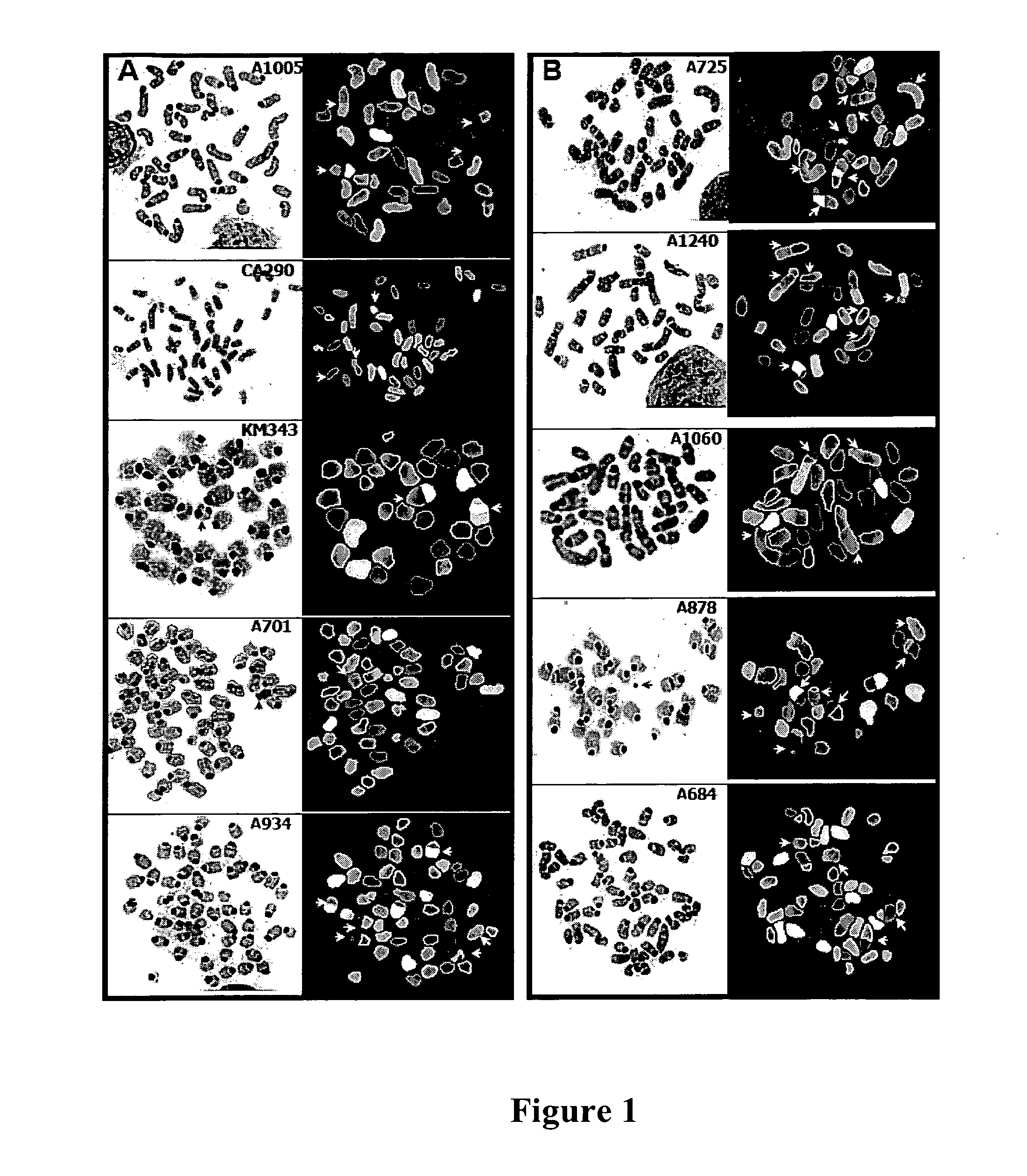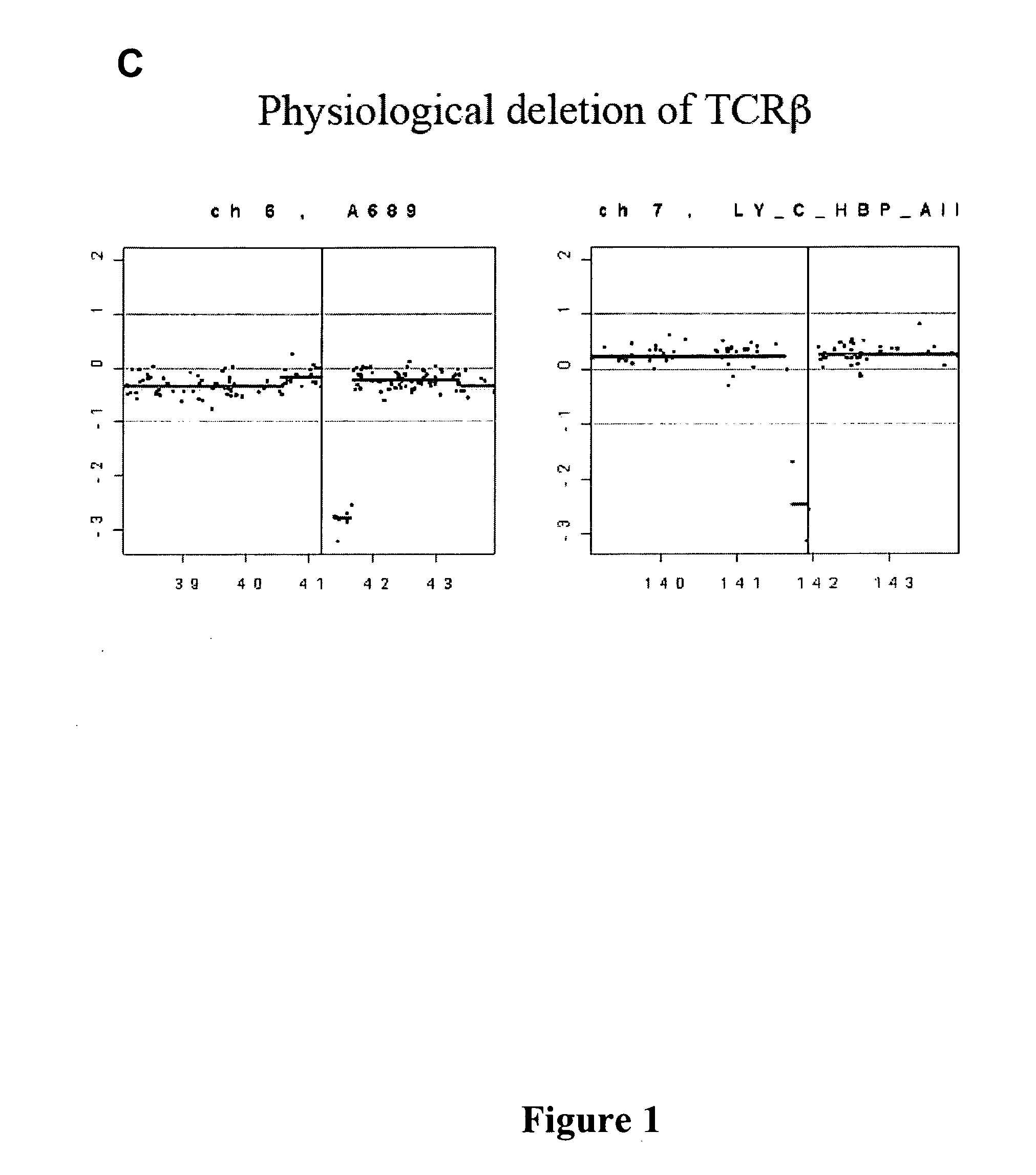Compositions and methods for cancer gene discovery
a cancer gene and gene discovery technology, applied in the field of genome instability animal cancer model for cancer gene discovery, can solve the problems of major challenges in the reorganization and mutation of cancer genomes
- Summary
- Abstract
- Description
- Claims
- Application Information
AI Technical Summary
Benefits of technology
Problems solved by technology
Method used
Image
Examples
example 1
Generation and Characterization of Murine T Cell Lymphomas with Highly Complex Genomes
[0145]In this example, we created a murine lymphoma model system that combines the genome-destabilizing impact of Atm deficiency and telomere dysfunction to effect T lymphomagenesis in a p53-dependent manner.
[0146]We interbred mTerc Atm p. 53 heterozygous mice and maintained them in pathogen-free conditions. We intercrossed the null alleles of mTerc, Atm and p53 to generate various genotypic combinations from this “triple”-mutant colony (for simplicity, hereafter designated as “TKO” for all genotypes from this colony).
[0147]We monitored animals for signs of ill-health every other day. Moribund animals were euthanized and subjected to complete autopsy; mice found dead were subject to necropsy specifically for signs of lymphoma. We performed all animal uses and manipulations according to approved IACUC protocol. Tumors were harvested from TKO mice and partitioned in the following manner. One section ...
example 2
TKO Lymphomas Harbor Genomic Alterations Syntenic to Those in Human T Cell Malignancy
[0152]To assess the degree of syntenic overlap in the murine lymphoma-prone TKO instability model and in human T-ALL and other cancers, we applied and integrated multiple genome analysis technologies to survey cancer-associated alterations for comparison with T-ALL and a diverse set of major human cancers.
[0153]Synteny describes the preserved order and orientation of genes between species. Disruption of synteny, caused by chromosome rearrangement, is an indication of divergent evolution. Comparisons of TKO mouse model and human T-ALL syntenic chromosomal regions may reveal the conserved nature of certain genetic modification in tumorigenesis.
[0154]Because TKO lymphomas harbored a large number of complex nonreciprocal translocations (NRTs), we sought to determine whether these genome-unstable tumors possess increased numbers of recurrent amplifications and deletions. To this end, we compiled high-res...
example 3
Frequent NOTCH1 Rearrangement in TKO Mouse Model
[0161]For further comparison of genomic events in the TKO model and in human T-All, we used a separate series of 38 human clinical specimens (Table 4C) for re-sequencing of NOTCH 1, FBXW7 and PTEN (see Examples 5-6). These T-ALL samples were collected from 8 children and adolescents diagnosed at the Royal Free Hospital, London, and 30 adult patients enrolled in the MRC UKALL-XII trial. Appropriate informed consent was obtained from the patients (if over 18 years of age) or their guardians (if under 18 years), and the study had Ethics Committee approval.
[0162]1. HPLC and Sequencing. Gene mutation status was established by denaturing high-performance liquid chromatography (see, e.g., M. R. Mansour, et al., Leukemia 20 (3), 537 (2006)), and by bidirectional sequencing. Briefly, genomic DNA was extracted using the Qiagen (Hilden, Germany) genomic purification kit. PCR primers were designed to amplify exons and flanking intronic sequences. ...
PUM
| Property | Measurement | Unit |
|---|---|---|
| Length | aaaaa | aaaaa |
| Structure | aaaaa | aaaaa |
| Therapeutic | aaaaa | aaaaa |
Abstract
Description
Claims
Application Information
 Login to View More
Login to View More - R&D
- Intellectual Property
- Life Sciences
- Materials
- Tech Scout
- Unparalleled Data Quality
- Higher Quality Content
- 60% Fewer Hallucinations
Browse by: Latest US Patents, China's latest patents, Technical Efficacy Thesaurus, Application Domain, Technology Topic, Popular Technical Reports.
© 2025 PatSnap. All rights reserved.Legal|Privacy policy|Modern Slavery Act Transparency Statement|Sitemap|About US| Contact US: help@patsnap.com



